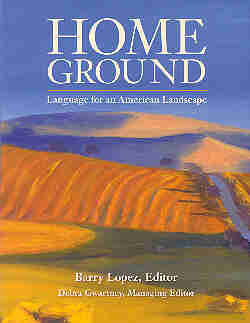Home Ground
Language for an American Landscape
Barry Lopez, Editor

“Throughout the American Southwest and into Mexico, the thunderstorms of the monsoon season sweep from above the sierras onto the deserts and brushlands, and within a few turbulent days the land receives much of its annual allotment of moisture. The pools and mud holes that form after these intense rains are called charcos, which in Spanish means “puddles.” The word is occasionally used when referring to the trenches dug under fences by deer, javelina, or feral hogs as they cross from one pasture to another, perhaps because the furrows fill with water after a rain.”
This passage comes from the book under consideration for September's Newswire, one titled Home Ground: Language for an American Landscape. Though it has no plot to speak of, and certainly no character development, Home Ground is full of intriguing tidbits of the distinctly American vocabulary we use to describe and characterize the country's landscape. Edited by Barry Lopez and Debra Gwartney, Home Ground contains over 850 definitions and descriptions for terms ranging from kudzu to groundwater, desert varnish to riffle, windbreak to hanging glacier, and hundreds of other in between. Forty-five writers contributed to Home Ground; each put his or her individual stamp on the sections he or she penned. The resulting work not only sheds light on landscape terms; it also tells of the way that landscape has shaped the American character. Consider the following passage on salt flats:
“When salt lakes dry up, whether permanently or temporarily, their beds become salt or alkali flats, glistening stretches of level, pale ground encrusted with saline minerals such as potassium, magnesium lithium, and sodium chloride. The evaporation of winter rains deposits salty materials – originally in solution – onto the floor of the lake basin, already smooth and flat because of its silt and clay base. Such is the case with the vast Bonneville Salt Flats west of Salt Lake City, Utah. Its more than thirty thousand acres are so buffed that for decades it has been the site for attempts on the world land speed record. Rogers Dry Lake on Edwards Air Force Base in California is firm and flat enough that it is used as a landing area for spacecraft. In the Southeast, the term salt flat is used quite differently. There it denotes low-lying, grassy coastal land, sometimes flooded with salt water but not as continuously wet as a salt marsh.”
And this, on massif:
“The word massif is French, meaning literally 'massive.' It refers to a compact and more or less independent mountain mass, either protruded through the Earth's crust or depressed as a unit and often bounded by faults. Not to be confused with the summit alone, massif refers to the entire configuration. A massif is composed of rocks more rigid than those of its surroundings, and from a different, often more ancient time. Examples are the Chain Lakes massif in the northern Appalachians and the Yukon Territory's Mount Logan, the second highest mountain in North America.”
If you've ever wondered why it's called Las Vegas, or why Natchez Trace and not Natchez Trail, or just wanted to know more about eskers or end moraines, this is the book for you. Home Ground is at once an invitation to learn American geography and to read American history; it's also a celebration of a most engaging dimension of the American character. Be sure to read all about it.
All Rights Reserved.